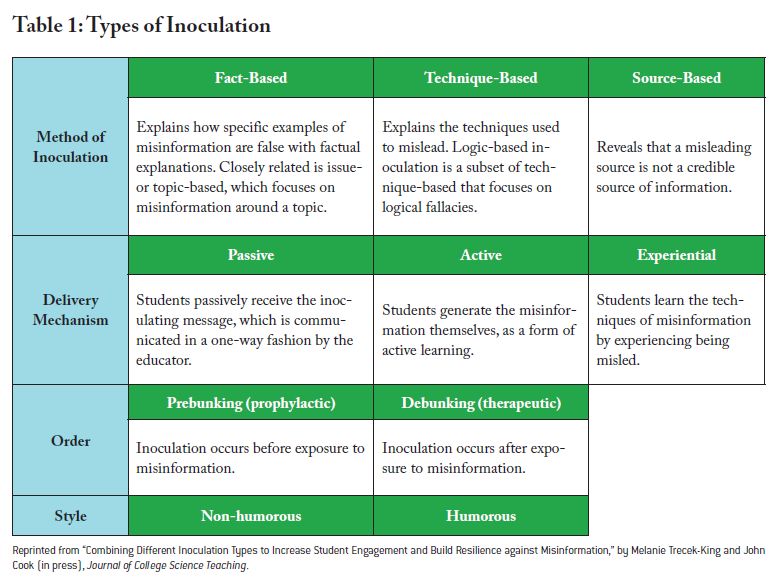Inoculate Against Misinformation
Want to protect your students from misinformation? Inoculate them against it!
Inoculation theory is based on a vaccine analogy. Like a vaccine builds immunity to a pathogen by exposing our bodies to a weakened form of the pathogen, we can build immunity to misinformation by exposing our minds to a weakened form of misinformation, along with strategies to resist the persuasion. Basically, instead of debunking, inoculation pre-bunks… and in the process trains our minds to identify (and therefore not fall for!) misinformation.
Inoculations can be either fact-based or logic-based. (A third, less studied, type of inoculation is source-based.) Fact-based inoculation corrects misinformation with factual explanations, and is therefore limited to the context of that particular topic. Technique-based inoculation explains the logical fallacies or rhetorical techniques that were used to mislead, providing resistance against the same techniques in different types of misinformation.
Inoculation can also be either passive, active, or experiential. Passive inoculation occurs when the facts or techniques used to mislead are explained to the audience, while active inoculation builds immunity by getting people to actively create the misinformation themselves. (John Cook and I recently proposed an additional delivery mechanism, experiential inoculation, in which students learn the techniques of misinformation by experiencing being misled.)
My favorite classroom inoculation activities combine active and technique-based, in which students create misinformation using the techniques that type of misinformation uses to mislead.

Imagine a young child watching a magic show for the first time. Without any prior knowledge, the tricks could really look like magic! To convince the child there was no magic involved, one could explain how the tricks were done. But the best way would be to teach them how to perform the tricks themselves. (Or as Mark Twain quipped, “A man who carries a cat by the tail learns something he can learn in no other way.”)
Examples of articles, assignments, and games that use active, technique-based inoculation
- How to sell pseudoscience in 9 easy steps: Protect yourself against potentially harmful health pseudoscience by learning the techniques used to sell it.
- Learn to be a psychic with these 7 tricks: Do you want to wow your friends and family with your psychic abilities? It’s not supernatural… it’s cold reading!
- Wake up, Sheeple!: In this fun critical thinking activity, students learn to recognize the characteristics of conspiracy theories by making their own.
- Please don’t fail me: Looking for a fun way to teach critical thinking, argumentation and logical fallacies? Have students create misinformation using humor!
- Cranky Uncle: The Cranky Uncle game uses cartoons and critical thinking to fight misinformation. The game was developed by Monash University scientist John Cook and is now available for free on iPhone and Android. (The Teacher’s Guide is available here.)
- Bad News: The Bad News game confers resistance against bad online information by putting players in the position of the people who create it. (Learn more about the research behind the game here.)
- Go Viral: New online infodemic game shows how to spot coronavirus misinformation in 5 minutes. Based on Cambridge University pre-bunking research.
- Harmony Square: A short, free-to-play online game in which players learn how political misinformation is produced and spread.
The above list is just the tip of the iceberg. For example, if you wanted to inoculate yourself (or your students) against shows like Ghost Hunters, you could learn how to create ghost photos or haunted houses! If it’s crop circles you’ve been wondering about, figure out how to make geometric patterns in fields. The possibilities are limitless.
Learn More: Featured Articles and Videos
Inoculating Students against Misinformation by Having Them Create It (Skeptical Inquirer): Gives a more detailed explanation of the types of inoculation as well as how to combine them to create your own activities. Includes an explanation of three inoculation activities.
Combining Different Inoculation Types to Increase Student Engagement and Build Resilience Against Science Misinformation (Journal of College Science Teaching): John Cook and I define and organize the various types of inoculation, which includes three delivery mechanisms that can be useful in the classroom—passive, active, and experiential. We then describe how the different types of inoculation can be creatively combined to maximize student engagement and learning.
Inoculate against Misinformation YouTube Playlist: Features presentations and other videos related to inoculation activities.
How to Inoculate Yourself against Misinformation (Thinking Is Power): Provides a general overview of inoculation theory and a list of activities and games.
Additional Resources
The Mental Immunity Project is an ambitious effort to help everyone develop their immunity to misinformation. It represents a collaboration between CIRCE (the Cognitive Immunology Research Collaborative) a global institute dedicated to advancing the science of mental immunity, and Thinking Is Power, a creative developer of tools for critical thinkers.
Foolproof: Why Misinformation Infects Our Minds and How to Build Immunity, by Sander van der Linden: One of the world’s leading misinformation researchers explains explains why we fall for misinformation and what we can do to protect ourselves and others.